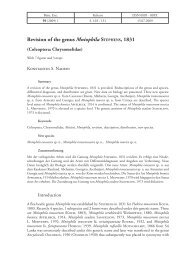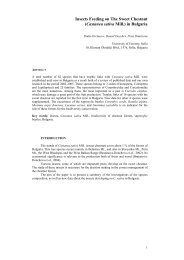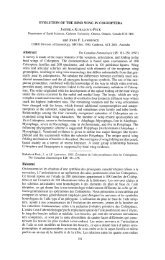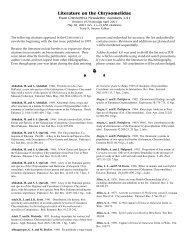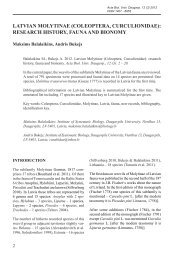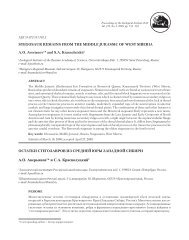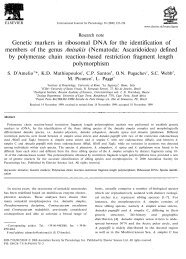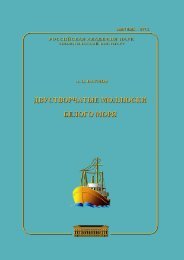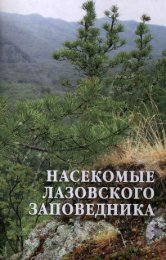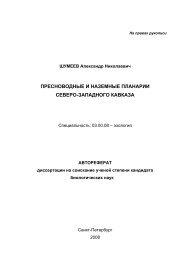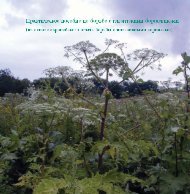Untitled
Untitled
Untitled
Create successful ePaper yourself
Turn your PDF publications into a flip-book with our unique Google optimized e-Paper software.
ISSN 2226-0773<br />
МЕЖДУНАРОДНЫЙ АЛЬМАНАХON<br />
INTERNATIONAL ALMANAC<br />
ГУМАНИТАРНОЕ ПРОСТРАНСТВО<br />
HUMANITY SPACE<br />
Том 2, No 3<br />
Volume 2, No 3<br />
ЭНТОМОЛОГИЯ<br />
ENTOMOLOGY<br />
МОСКВА<br />
MOSCOW<br />
2013
Гуманитарное пространство<br />
Международный альманах ТОМ 2, No 3, 2013<br />
Humanity space<br />
International almanac VOLUME 2, No 3, 2013<br />
Главный редактор / Chef Editor: М.А. Лазарев / M.A. Lazarev<br />
E-mail: cerambycidae@fromru.com<br />
Дизайн обложки / Cover Design: М.А. Лазарев / M.A. Lazarev<br />
Научный редактор / Scientific Editor:<br />
В.П. Подвойский / V.P. Podvoysky<br />
E-mail: 9036167488@mail.ru<br />
Литературный редактор / Literary Editor:<br />
О.В. Стукалова / O.V. Stukalova<br />
E-mail: chif599@gmail.com<br />
Веб-сайт / Website: http://www.humanityspace.com<br />
Издательство / Publishers: Higher School Consulting<br />
Tovarishchensky side street, 19, office19, Moscow, Russia<br />
Напечатано / Printed by: AEG Group Design & Printing<br />
Gruzinsky Val, 11, Moscow, 123056 Russia<br />
Дата выпуска / Date of issue: 01.07.2013<br />
Реестр / Register: ISSN 2226-0773<br />
Гуманитарное пространство. Международный альманах //<br />
Humanity space. International almanac<br />
составление, редактирование<br />
compiling, editing
Humanity space International almanac VOL. 2, No 3, 2013: 443-448<br />
Two new subspecies of Agapanthia dahli (Richter, 1821) from<br />
Dagestan and Armenia (Coleoptera, Cerambycidae)<br />
M.A. Lazarev<br />
Bolshaya Serpukhovskaya str. 34, building 4, apartment 79, Moscow 115093<br />
Russia; e-mail: cerambycidae@fromru.com<br />
Key words: Taxonomy, zoogeography, new subspecies, new rank, Coleoptera,<br />
Cerambycidae, Agapanthia, Dagestan, Armenia, Azerbaijan.<br />
Abstract: Agapanthia dahli rubenyani, ssp. n. is described from South Armenia<br />
(Megri district), Agapanthia dahli ismailovae, ssp. n. is described from Dagestan<br />
and North Azerbaijan. Agapanthia dahli walteri Reitter, 1898, new rank, A. d.<br />
nitidipennis Holzschuh, 1984, new rank, A. d. muellneri Reitter, 1898, new rank,<br />
A. d. alexandris Pic, 1901, new rank, A. d. persica Semenov, 1893, new rank and<br />
A. d. transcaspica Pic, 1900, new rank are downgraded from species level.<br />
INTRODUCTION<br />
The distinguishing characters between 7 taxa generally<br />
accepted as species - Agapanthia dahli (Richter, 1821) A. walteri<br />
Reitter, 1898, A. nitidipennis Holzschuh, 1984, A. muellneri Reitter,<br />
1898, A. alexandris Pic, 1901, A. persica Semenov, 1893 and A.<br />
transcaspica Pic, 1900 – are only limited by the characters (densety,<br />
color, length, size and shape of elytral patches). All 7 are vicariants<br />
and each two can never occur in one locality, but food plants are<br />
about the same in all seven.<br />
Several early attempts to regard certain names as synonyms<br />
(A. muellneri and A. alexandris by Plavilstshikov, 1968; or A.<br />
persica and A. transcaspica by Shapovalov, 2009) can not be<br />
accepted. Many synonyms proposed by Kostin (1978) in Agapanthia<br />
were also unacceptable.<br />
All of them are admitted here as subspecies: Agapanthia dahli<br />
walteri Reitter, 1898, new rank, A. d. nitidipennis Holzschuh, 1984,<br />
new rank, A. d. muellneri Reitter, 1898, new rank, A. d. alexandris<br />
Pic, 1901, new rank, A. d. persica Semenov, 1893, new rank and A.<br />
d. transcaspica Pic, 1900, new rank<br />
In fact many well known populations of A. dahli-complex are<br />
much more peculiar than taxa mentioned above. Two of them are<br />
described bellow as new subspecies, while others (from Aktyubinsk<br />
443
M.A. Lazarev<br />
area, from Gissar Ridge, Zaisan depression and Altay Mountains<br />
system need further investigation.<br />
The taxons of A. dahli-complex are widely distributed all over<br />
Caucasus. The Central Transcaucasia are occupied by A. d. walteri<br />
with a transition to A. d. dahli in West Georgia and North-East<br />
Caucasus. The Transcaucasian area in Georgia northwards Armenian<br />
A. d. walteri (Gori, Tbilisi, Lagodekhi, Vashlovani) belongs to A. d.<br />
nitidipennis. The populations of A. dahli from Dagestan with<br />
neighbor areas of North Azerbaijan and from South Armenia (Megri<br />
and Goris districts) with neighbor areas of South Azerbaijan are<br />
similar to A. d. nitidipennis because of grey humeral stripes in the<br />
most of specimens, but differs by very dense dorsal pubescence and<br />
strongly distant from each other. Both areas contain own well<br />
pronounced subspecies.<br />
Agapanthia dahli rubenyani ssp. n.<br />
(Figs 1-2)<br />
Type locality. South Armenia, Megri District, mountains above<br />
Shvanidzor, 39°13'N, 46°22'44''E, 1600 m.<br />
Diagnosis. Body black with numerous erect black setae; moderately<br />
long; head with dense yellow pubescence, condensed between<br />
antennae bases; genae about as long as lower eye lobes, densely<br />
covered with yellow pubescence; eyes a little convex, about flat, with<br />
deep notch; the distance between upper eye lobes is about 1.5-2 mm,<br />
the length of frons from 1.3 to 1.9mm; antennae thin, 1 st and 2 nd<br />
joints black, other joints red basally and black distally; reaching<br />
beyond elytral apices with 5 joints in males and 3 joints in females;<br />
red antennal areas with white recumbent pubescence; 3rd antennal<br />
joint with distinct setae tuft; other joints with more or less numerous<br />
semierect setae; prothorax transverse, its width anteriorly: 1.3-2.3<br />
mm, posteriorly: 2.2-3.0 mm; its maximal width behind middle: 2.5-<br />
3.4 mm, prothorax length: 2.5-2.7 mm; pronotal punctation consists<br />
of distinct big dots with fine punctures in between; elytra with<br />
scattered spots of yellow pubescence which can be more or less<br />
numerous; humeri usually with distinct wide stripe of very fine grey<br />
pubescence, which can be sometimes poorly developed or indistinct;<br />
444
M.A. Lazarev<br />
elytral length: 8.1-12.1 mm, width: 2.5-4.9 mm, elytra about 2 times<br />
wider than long; femora and tibiae with fine punctation, covered by<br />
dense pale pubescence; body length in males: 11.3-16.5 mm, width:<br />
2.5-4.4 mm; body length in females: 12.8-19.5 mm; width: 2.9-4.9<br />
mm.<br />
Remark. Agapanthia dahli rubenyani ssp. n. easily differs from A.<br />
d. walteri Reitter, 1898 by the presence of grey humeral stripe,<br />
besides elytral spots of dense yellow setae less concentrated,<br />
diffused. Similar grey humeral elytral strip is also known in A. d.<br />
nitidipennis Holzschuh, 1984, which is strongly distant (distributed<br />
in East Georgia) and characterized by very sparse elytral pubescence.<br />
Distribution. Three localities are known in South Armenia: Megri<br />
district above Shvanidzor, 39°13'N, 46°22'44''E, 1600 m. and<br />
38°57'14''N, 46°22'41''E, 900 m; Lichk above Megri; Goris environs,<br />
Tekh, 39°34'6''N, 46°25'52''E, 1600 m; and two in South Azerbaijan:<br />
Zangelan environs, 39°4'16''N, 46°36'44''E, 590 m.; Kubatly<br />
environs, 39°22'11''N, 46°34'50''E, 690 m.<br />
Material. Holotype, 1 male, “Armenia, above Shvanidzor, 39°13'N,<br />
46°22'44''E, 1600 m., 5-6.5.2013, A.Rubenyan” - collection of M.L.<br />
Danilevsky (Moscow); 38 paratypes (collection of M.L. Danilevsky):<br />
15 males, 15 females, Armenia, above Shvanidzor, 39°13'N,<br />
46°22'44''E, 1600 m., 05-06.05.2013, A.Rubenyan; 2 males,<br />
Armenia, Shvanidzor, 38°57'14''N, 46°22'41''E, 900 m., 05.05.2013,<br />
A.Rubenyan; 1 male, Armenia, Tekh, 39°34'6''N, 46°25'52''E, 1600<br />
m., 03.05.2013, A.Rubenyan; 1 male, Azerbaijan, 2 km N Kubatly,<br />
39°22'11''N, 46°34'50''E, 690 m., 06.05.2013, A.Rubenyan; 1 female,<br />
Azerbaijan, Zangelan, 39°4'16''N, 46°36'44''E, 590 m., 05.05.2013,<br />
A.Rubenyan; 1 male and 1 female, Armenia, Lichk, 1.7.1986, O.<br />
Gorbunov leg.; 1 male, 4-8 km N Shvanidzor, 19-24.5.2005,<br />
Karagyan leg.<br />
Dedication. The new taxon is dedicated to a well known experienced<br />
insect collector Artem Rubenyan (Moscow) who collected the most<br />
part of the type series.<br />
445
M.A. Lazarev<br />
Agapanthia dahli ismailovae ssp. n.<br />
(Figs 3-4)<br />
Type locality. North Cucasus, Dagestan, Rutul env.<br />
Diagnosis. Very similar to Agapanthia dahli rubenyani ssp. n.<br />
because of distinct grey humeral stripe and dense bright elytral<br />
pubescence, but differs by a little darker pubescence with more<br />
contrast elytral setae patches; body length in males: 15.6-17.8 mm,<br />
width: 3.7-4.5 mm; body length in females: 13.1-17.2 mm; width:<br />
3.2-4.4 mm.<br />
Distribution. North Caucasus, Dagestan, Rutul env.; North-East<br />
Azerbaijan, Altyagatch.<br />
Material. Holotype, 1 male, Dagestan, Rutul env., 24.6.2001, M.<br />
Ismailova leg. - collection of M.L. Danilevsky (Moscow); 3<br />
paratypes (same collection): 1 male, 1 female, with same label; 1<br />
female, Azerbaijan, Altyagach, 10.7.1979, M.Danievsky leg.<br />
Dedication. The new taxon is dedicated to Madina Ismailova, who<br />
collected the most part of the type series.<br />
REFERENCES<br />
Audinet-Serville 1. O. A. 1835. Nouvelle classification de la famille des longicornes<br />
(suite).- Annales de la Société Entamalogique de France, 4: 5-100, pI. 3.<br />
Bense U., 1995. Longhorn beetles. Illustrated key to the Cerambycidae and<br />
Vesperidae of Europe. Weikersheim: 512 pp.<br />
Danilevsky M.L., Miroshnikov A.I., 1985. Timber-Beetles of Caucasus (Coleoptera,<br />
Cerambycidae). Key.- Krasnodar: 419 pp.<br />
Holzschuh C. 1984. Beschreibung von 24 neuen Bockkafem aus Europa und Asien,<br />
vorwiegend aus dem Himalaya (Col., Cerambycidae).- Entomologica<br />
Basiliensia, 9: 340-372.<br />
Plavilstshikov N.N. 1948. A Key for Longicorn Beetles of Armenia. Erevan. 232 pp.<br />
[in Russian]<br />
Plavilstshikov N.N. 1968. Review of the genus Agapanthia Serv. (Coleoptera,<br />
Cerambycidae) of the USSR fauna.- Archives of Zoological Museum<br />
Moscow State University, v. 11: 113-168.<br />
Pic M. 1901. Notes diverses et diagnoses (8e article).- L’Échange, Revue Linnéene,<br />
17 (203): 81-83.<br />
Pic M. 1900. Descriptions. Pp. 11-16.- Matériaux pour servir à l’étude des<br />
longicornes. 3ème cahier, 3re partie. Lyon: Imprimerie Jacquet Freres, 33<br />
pp.<br />
Reitter E. I898. Ueber die bekannten und einige neue palaearctische Agapanthia-<br />
446
M.A. Lazarev<br />
Arten.- Wiener Entomologische Zeitung, 17: 130-135.<br />
Rejzek M., G. Sama, G. Alziar, 2001. Host plants of several herb-feeding<br />
Cerambycidae mainly from East Mediterranean Region (Coleoptera:<br />
Cerambycidae).- Biocosme Mésogéen, Nice, 17(2000), 4: 263-294.<br />
Sama G. 2002. Atlas of the Cerambycidae of Europe and the Mediterranean Area.<br />
Vol.1. Nakladatelství Kabourek. Zlín: 173pp.<br />
Semenov [Semenow A.] A. P. 1893. Coleoptera asiatica nova.- Horae Societatis<br />
Entomologicae Rossicae, 27 [1892-1893]: 494-507.<br />
Shapovalov A. M. 2009: New species of the genus Agapanthia Serville, 1835<br />
(Coleoptera, Cerambycidae) from South-West Kazakhstan.- Eversmannia,<br />
Entomological research in the Russia and adjacent regions, No 19-20: 16-20<br />
+ 1 plate.<br />
447
M.A. Lazarev<br />
Figs 1-2. Agapanthia dahli rubenyani ssp. n.<br />
1 – male, holotype, Armenia, above Shvanidzor, 39°13'N, 46°22'44''E, 1600<br />
m., 5-6.5.2013, A.Rubenyan leg.; 2 – female, same locality.<br />
Figs 3-4. Agapanthia dahli ismailovae ssp. n.<br />
3 - male, holotype, Dagestan, Rutul env., 24.6.2001, M. Ismailova leg.; 4 –<br />
female, same locality.<br />
Received: 14.06.2013<br />
Accepted: 17.06.2013<br />
448




